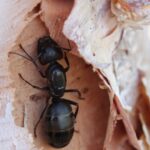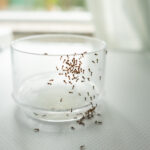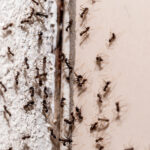How Can We Help?
What do ants eat?
Ants are omnivorous insects, meaning they eat a wide variety of foods, which can vary a lot depending on their  species and habitat. Generally, ants munch on a mix of proteins, carbohydrates, and fats to stay healthy. Proteins are crucial for their larvae's growth and development, and ants usually get these from other insects, dead animals, and small invertebrates. Some species hunt live prey, while others prefer scavenging for carcasses. Carbohydrates, mainly sugars, give adult ants the energy they need. They often get these from plant nectar, honeydew from aphids and other plant-sucking insects, and sugary fruits. Many ants are also attracted to sweet human foods like candies, syrups, and sodas, which is why they sometimes invade homes and kitchens.
species and habitat. Generally, ants munch on a mix of proteins, carbohydrates, and fats to stay healthy. Proteins are crucial for their larvae's growth and development, and ants usually get these from other insects, dead animals, and small invertebrates. Some species hunt live prey, while others prefer scavenging for carcasses. Carbohydrates, mainly sugars, give adult ants the energy they need. They often get these from plant nectar, honeydew from aphids and other plant-sucking insects, and sugary fruits. Many ants are also attracted to sweet human foods like candies, syrups, and sodas, which is why they sometimes invade homes and kitchens.
Fats are less commonly sought but still part of their diet, usually coming from seeds, nuts, and oily food scraps. Leafcutter ants have a unique way of eating; they cut leaves and carry them back to their colonies to grow fungus, which they eat. This cool relationship with fungus farming shows just how varied ant diets can be. In urban areas, ants often become opportunistic eaters, thriving on a wide range of human food waste, including greasy and protein-rich leftovers. Ants have highly organized foraging behavior, with complex trail systems and sophisticated communication among colony members to efficiently find and transport food. This adaptability in diet and foraging strategy makes ants one of the most successful and resilient insect groups worldwide, thriving in environments from dense forests to bustling cities.
How do ants find food sources?
Ants have an incredibly efficient and organized way of finding food, using their keen senses and sophisticated communication methods. It all starts with scout ants exploring their environment for food. These scouts rely on their strong sense of smell and touch to detect food. When a scout finds something edible, it takes a small bite and heads back to the colony, leaving a trail of pheromones—chemical signals that act as a guide for other ants. The strength of this pheromone trail reflects the quality and quantity of the food, encouraging more ants to follow stronger trails.
Once at the food, worker ants work together to transport it back to the colony. The constant reinforcement of the pheromone trail ensures a steady flow of ants between the colony and the food source. If the food is plentiful, more ants will follow the trail, making the signal stronger and establishing a clear path. On the flip side, if the food runs out or isn't that good, the pheromone trail fades, and the ants move on to other tasks.
Ants also use touch and sound to communicate, especially when facing obstacles or dangers. Some ants practice
This decentralized yet highly coordinated system allows ants to make the most of food resources in their environment, adapt to changes, and ensure their colony thrives. Combining chemical, tactile, and sometimes even visual cues, ants can navigate complex terrains and find food with impressive precision and efficiency.
Why are ants attracted to sugary foods like candy and soda?
Ants are particularly lured to sugary foods like candy and soda due to their high carbohydrate content, which is crucial for their energy needs. Carbohydrates, primarily in the form of sugars, provide ants with the quick energy required for their active lifestyles, including foraging, building nests, and taking care of their young. The high sugar concentration in foods like candy and soda is especially appealing because it offers a readily accessible and concentrated energy source. When ants detect the presence of sugary foods, usually through their keen sense of smell, they are quick to mobilize and exploit these resources.
The attraction to sugary substances is also linked to the ants' natural feeding habits. In the wild, ants frequently consume plant nectar and honeydew excreted by aphids, both of which are rich in sugars. This preference for sweet substances is an evolutionary adaptation that helps ants locate energy-rich food sources. When they encounter similar high-sugar content in human foods, they instinctively follow the scent trail to the source.
The availability of sugary foods in human environments, such as kitchens and outdoor picnic areas, provides ants with easy access to these desirable treats. The persistence and tenacity of ants in seeking out sugary foods can lead to frequent and often challenging infestations in homes and businesses. Their ability to quickly detect and exploit these food sources underscores the importance of maintaining cleanliness and proper food storage to deter ant invasions.
Do ants have preferences for certain types of foods over others?
Ants have their favorite foods, just like we do, and their choices are often influenced by what they need nutritionally, their species-specific diets, and their surroundings. Generally, ants look for a mix of carbs, proteins, and fats, though what they prefer can vary a lot between species. Many ants go for sugary foods because they provide the energy needed for their busy foraging and keeping the colony running. You'll often see them attracted to things like nectar, honeydew, fruits, and even candy and soda.
But protein is just as important, especially for the growth of their larvae. Predatory ants, like those in the genus Pheidole, often go for insect prey and other protein-rich sources, scavenging dead animals or hunting live insects. Leafcutter ants (Atta and Acromyrmex species) are unique in that they prefer plant material, which they use to grow fungus, their main food source—a neat symbiotic relationship that fulfills their nutritional needs.

Ants are pretty sophisticated when it comes to finding food, quickly adapting their preferences based on the colony's needs and what's available. This adaptability helps them survive in all sorts of environments, from tropical forests to urban areas. So, while ants do show a preference for certain foods, these preferences are flexible and can change according to the colony's nutritional demands and environmental conditions. Here at Youngs Pest Control, we understand the complexities of ant behavior and can provide effective solutions for all types of ant infestations.
